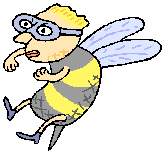 BE CAREFUL!
BE CAREFUL! Adverbs
An adverb is usually defined as a word that gives more information about a verb.
Adverbs are used to modify a verb, an adjective, or another adverb.
Example:
Adverbs are often formed by adding -ly to an adjectives.
Example:
 BE CAREFUL!
BE CAREFUL!
NOT! - He plays tennis good.
Adverbs do
not modify nouns
or pronouns.
Adverbs answer the questions how, when , and where.
There are many different types of adverbs. Some examples of adverbs are simple, interrogative, and conjunctive adverbs.
A simple adverb is used as a modifier telling manner, time, place, degree, or number.
Examples:
Comparative adverbs are used for making comparisons.
Examples:
An interrogative adverb asks a question.
Example:
A conjunctive adverb connects two independent clauses. Some common conjunctive adverbs are accordingly, also, anyhow, besides, consequently, however, moreover, nevertheless, otherwise, still, then, therefore, and yet.
Example:

Some common mistakes